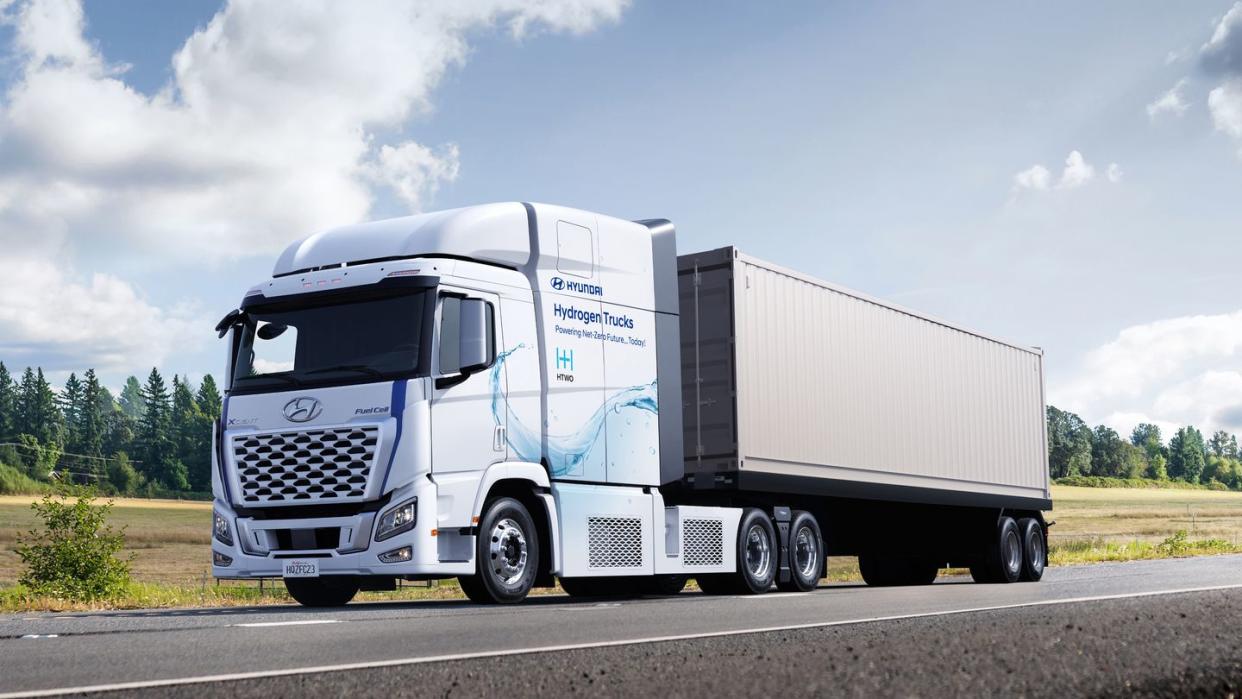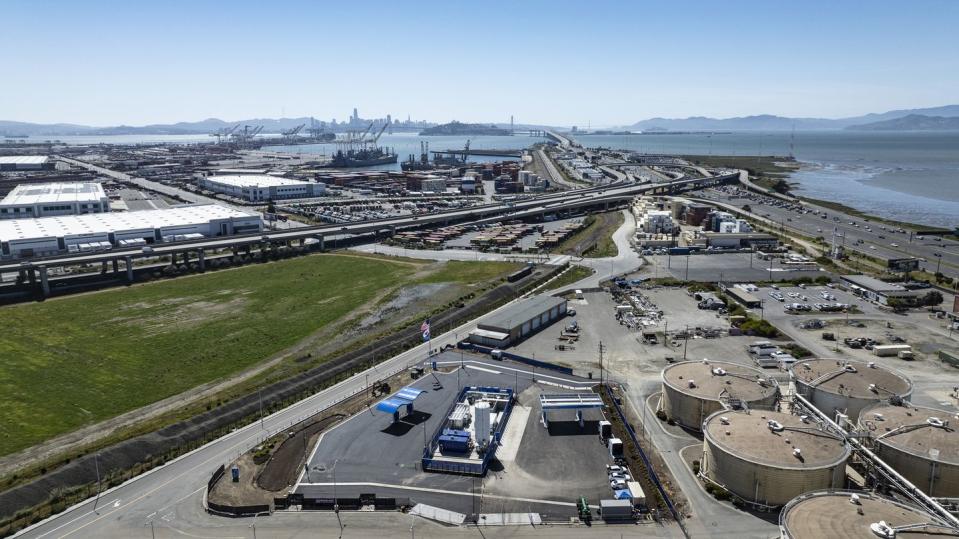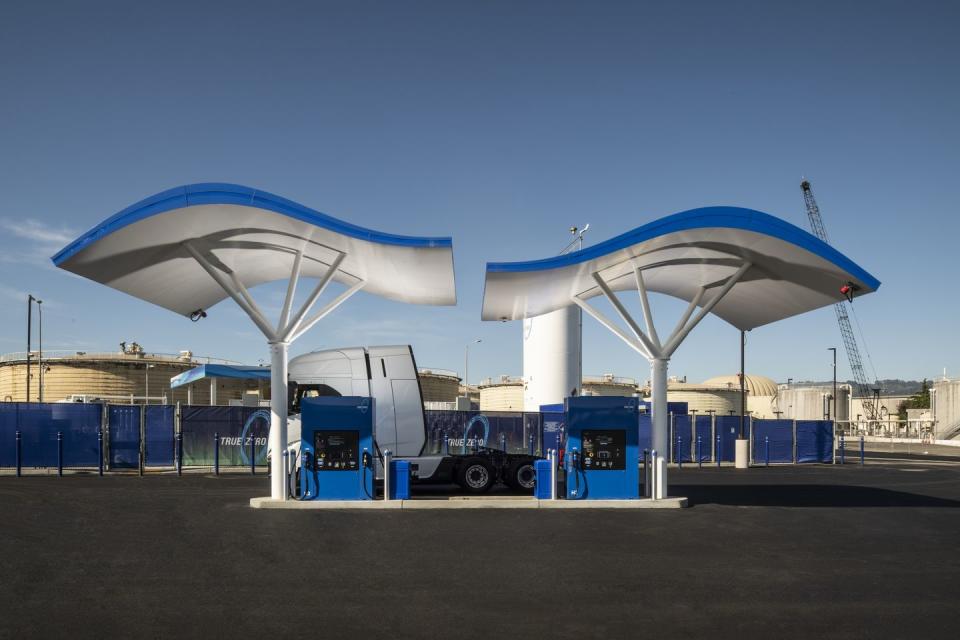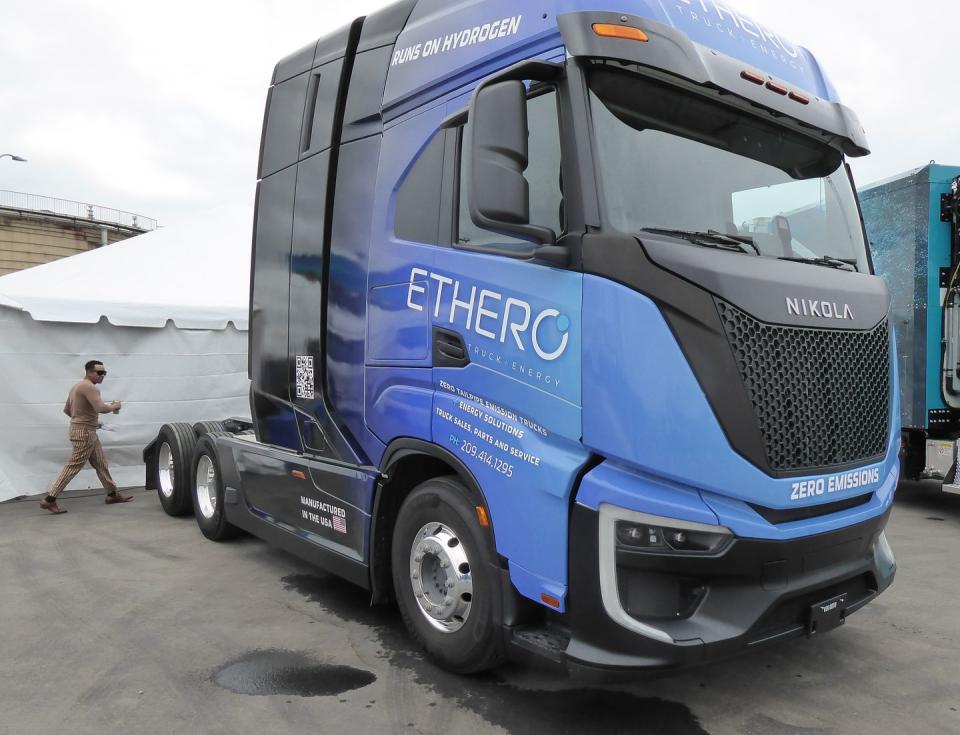Oakland Port Hosts World’s First Large-Scale Commercial Hydrogen Truck Stop

At the Port of Oakland, FirstElement Fuel opens what has been called “the world’s first commercial truck stop for hydrogen vehicles, with 10 times the capacity of any previous station.”
Hyundai XCIENT fuel-cell tractors, carrying 68.6 kilograms of hydrogen each for 450 miles of range, have been dedicated to the station for “drayage” duty. Hydrogen trucks from Nikola will also be operating out of Oakland and buying fuel from FirstElement.
Other companies committed to building fuel-cell hydrogen trucks or powertrains include Cummins, Bosch, Daimler, Toyota, Volvo, and Quantron, a German company that signed a memorandum of understanding with FEF.
The Port of Oakland is a major pollution generator. The highest levels of carcinogenic diesel particulate matter in the Bay Area are found in West Oakland, near the port where heavy and constant truck traffic moves containers in and out.
The diesel trucks relegated to this duty are often poorly maintained, high-mileage gross polluters—along with the megaships themselves, which burn low-grade “bunker fuel.” Running at 24 knots, they’ll burn 225 tons of it every day, but even sitting at the dock they often keep the engines running.
Initiatives have sought to reduce ship idling (by connecting to onshore electricity), replace older trucks, and reduce diesel emissions with particulate filters. A Maersk container ship is now running on methanol, an improvement.
And in 2021, Shippers Transport Express started using an electric fleet of 10 trucks at the Oakland port, which spent $1.7 million on charging stations. Because of programs like these, diesel emissions at the port declined 98% between 2005 and 2017, but there’s still a long way to go.
Another approach is taken by FirstElement Fuel (FEF), which has opened what Shane Stephens, FEF’s co-founder and chief development officer, calls “the world’s first commercial truck stop for hydrogen vehicles, with 10 times the capacity of any previous station.”
A fleet of 30 fuel-cell Hyundai XCIENT 6x4 cab-over tractors with 350-kW motors, carrying 68.6 kilograms of hydrogen each for 450 miles of range, has been dedicated to the station for “drayage” duty.

That means moving loaded shipping containers 50 to 60 miles to distribution centers. Hydrogen trucks from Nikola will also be operating out of Oakland and buying fuel from FirstElement.
“Hyundai is proud to be part of the largest deployment of heavy-duty hydrogen trucks in North America,” Eugene Litvinov, director of hydrogen and commercial vehicles at Hyundai, said during a ceremony at the station. “Ports can be the heaviest polluters of local communities. I volunteered for this role because I really believe in the future of fuel cells. We need more projects like this to achieve scale.”
Hydrogen is still very expensive, at around $15 per kilogram at the station level once commercial scale is achieved. A kilo has roughly the energy equivalent of a gallon of gasoline. But fuel cells are much more efficient than diesel engines. And they also get rid of the tailpipe; the hydrogen is used onboard to create power for an electric drivetrain.
The Oakland hydrogen station is subsidized by state money, with patronage from the California Energy Commission (CEC) and California Air Resources Board (CARB), among others.
Liane Randolph, CARB’s chair, said at the dedication ceremony that “a suite of technologies,” including both battery-electrics and hydrogen vehicles, are needed to clean the state’s air and address global warming. “It’s not an either/or,” she said. “We’ve seen some amazing battery trucks that can operate in a return-to-base mode. There’s room for both.”
Plug In America, which advocates for battery-electric vehicles, declined to comment on the new hydrogen station. Oliver Dixon, a senior analyst at Guidehouse Insights, said the short distances involved in drayage operations don’t fully play to the fuel-cell vehicle’s range advantage over EVs. And “the rate for drayage is on the low end of an already low-margin industry,” he said.
But, Dixon added, “If the shipping lines are getting serious about decarbonization, then it’s not impossible that the drayage operators will have to follow suit in a manner acceptable to those lines. It’s a big leap from there to a coherent business case for fuel-cell trucks, but stranger things have happened. And with more than 50% of global container capacity controlled by EU-domiciled carriers, I wouldn’t want to second-guess the ultimate direction of travel.”
With government credits, FEF can maybe break even selling $15-per-kilo hydrogen at its current size, Stephens said. The company has more than 80% hydrogen-vending market share in California and has dispensed 6.8 million kilograms of hydrogen, but it still needs to grow.
Joel Ewanick, FEF founder and executive chairman of the board, said that to reach unassisted profitability the company would need approximately 70 stations. “We need that kind of scale to reach a tipping point,” he said.

The Oakland station, operating under the True Zero brand, can deliver 18,000 kilograms of hydrogen daily—a lot more than at the 41 lighter-duty stations that FEF operates in California. Some 200 large trucks can be refueled daily, two at a time. More than a dozen other truck stops are planned.
FEF has been in business since 2013, mostly refueling the hydrogen passenger vehicles (16,000 now) on the road from automakers such as Hyundai, Honda, and Toyota. Stephens admitted many infrastructure mistakes were made in those early days, with fuel-cell cars queuing up and often waiting 45 minutes for fuel. Early stations could dispense only 200 kilograms per day.
Oakland achieves faster fills—under 10 minutes is possible—with two innovations: The hydrogen in its tanks is in a high-density liquid state, achieved by cooling it to -423 degrees Fahrenheit. The hydrogen is produced at an Air Liquide station north of Las Vegas and trucked to Oakland, with each 48-foot truck able to carry 4,000 kilograms.
On site it’s stored in a cryogenic tank. The liquid is turned back into a gas when it goes into the trucks. But thanks to the second innovation—a Bosch Rexroth-engineered cryogenic “cryopump”—the station could actually refuel trucks with liquid hydrogen (if and when there are fleets that could handle it).
FEF is ready for critics who say that producing hydrogen from natural gas, as Air Liquide and other suppliers do, isn’t all that green.
The company offsets the environmental effects of the hydrogen production by buying methane biogas (a major global warming emitter) from crop waste, landfills, and dairy farms, which is then injected into the natural gas stream via energy trader Matsui. Because of this, FEF’s hydrogen is certified as zero carbon on a well-to-wheels basis by CARB.

Bosch Rexroth’s two-stage cryopump, developed in partnership with FEF, enables much faster (700 bar), simpler, and more direct hydrogen flow, and also eliminates the need for a lot of backup infrastructure—the vast network of pipes, gauges, and tanks typically seen around a refueling station.
It needs 1/30th of the space, the company said, and can deliver 2,400 kilos of hydrogen per hour. Speaking at the FEF logistics center and proving grounds in Livermore, David Hull, a Bosch Rexroth regional vice president, said the cryopump will be on the market by early 2025. “We’re at a unique moment,” he said. “This makes it doable.”
The big problem with liquid hydrogen is “boil off.” To remain liquid, cryogenic temperatures have to be maintained and serious insulation applied, otherwise the expensive hydrogen will start venting to the atmosphere at an unnerving rate of 1% per day. Bosch’s Hull said the cryopump doesn’t heat up the hydrogen, reducing that problem.
Liquid hydrogen works best in vehicles that are going to use it right away, which makes it ideal for heavy-duty trucks and less useful in cars and pickups which might, for example, sit at an airport for a week, slowly leaking hydrogen.
FEF’s hydrogen stations, including Oakland, maintain light-duty hydrogen fueling for smaller vehicles, but that’s strictly compressed gaseous hydrogen.
The initial thought was that California’s hydrogen refueling would extend beyond California and make sales of fuel-cell cars viable nationwide, but so far that hasn’t happened. Southern California has the largest network in the country, with nothing comparable elsewhere in America.

The Hyundai trucks are operated by Global Expedited Transportation. During a ride around the port, driver Quentin Sten said the hydrogen trucks are a major improvement in quietness and maneuverability. “They’re really heavy, but you don’t feel the weight,” he said. “And it takes a while to get used to how quiet they are.”
Also in Oakland, in addition to a Nikola fuel-cell tractor, was a Cummins fuel-cell truck outfitted as relief support. It’s a demonstrator now, but it can travel 90 miles to a disaster site, provide a tactical headquarters in the rear, and then export 72 hours of backup power for operations, said the company’s Gerardo Zarate.
Tom Swenson, Cummins’ global regulatory affairs director, said the company is also working on a range of internal-combustion engines that will burn hydrogen. “We’re working on both technologies—fuel cells and combustion,” he said.
“We think they’re synergistic. If we can use existing engines, we can speed up the ramp rate for hydrogen adoption,” he said. “Cummins has a big background in natural gas and knows how to do the tanks.” A 2028 commercialization date is targeted.
Bosch is also working on a hydrogen combustion engine, and a 1976 Jeep Cherokee that burns hydrogen was displayed at the Consumer Electronics Show this year.
Other companies committed to building fuel-cell hydrogen trucks include Daimler, Toyota, Volvo, and Quantron, a German company that signed a memorandum of understanding with FEF.
“Electric cars are easy at first. But as you need bigger transformers and an expanded grid it gets harder,” said Stephens. “Hydrogen is harder at first, but it gets easier with scale.”
Should automakers give up on the dream of hydrogen-powered passenger vehicles and instead focus on commercial trucking ventures like these? Please comment below.

